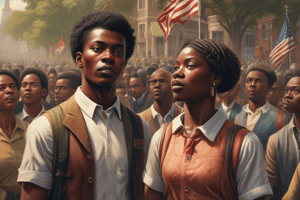Podcast
Questions and Answers
What was the impact of Plessy v.Ferguson on the Civil Rights Movement?
What was the impact of Plessy v.Ferguson on the Civil Rights Movement?
- It led to the immediate end of racial segregation
- It had no significant impact on the movement
- It galvanized the movement to end racial segregation (correct)
- It led to the passage of stricter Jim Crow laws
What was the basis for racial segregation in the South?
What was the basis for racial segregation in the South?
- The 13th Amendment to the US Constitution
- The 'Separate But Equal' doctrine (correct)
- The Reconstruction Era Amendments
- The Civil Rights Act of 1866
What was the reality of facilities for African Americans under the 'Separate But Equal' doctrine?
What was the reality of facilities for African Americans under the 'Separate But Equal' doctrine?
- They were non-existent
- They were often inferior and underfunded (correct)
- They were equal in quality
- They were superior in quality
What were the Jim Crow laws?
What were the Jim Crow laws?
What was the Supreme Court's decision in Plessy v.Ferguson?
What was the Supreme Court's decision in Plessy v.Ferguson?
What was the impact of Plessy v.Ferguson on racial segregation?
What was the impact of Plessy v.Ferguson on racial segregation?
What was the purpose of the 'Separate But Equal' doctrine?
What was the purpose of the 'Separate But Equal' doctrine?
What was the result of Plessy v.Ferguson for African Americans?
What was the result of Plessy v.Ferguson for African Americans?
What was the significance of Homer Plessy's arrest?
What was the significance of Homer Plessy's arrest?
What was the context of Plessy v.Ferguson?
What was the context of Plessy v.Ferguson?
Study Notes
Plessy v. Ferguson (1896)
Civil Rights Movement
- Plessy v. Ferguson was a landmark case that played a significant role in the Civil Rights Movement of the 1950s and 1960s.
- The case highlighted the injustices faced by African Americans and galvanized the movement to end racial segregation.
Racial Segregation
- The case centered around Homer Plessy, a Louisiana man who was arrested for sitting in a "whites-only" railroad car.
- Racial segregation was enforced in the South, with separate facilities and services for blacks and whites.
- Segregation was justified by the "Separate But Equal" doctrine, which claimed that separate facilities were equal in quality.
Separate But Equal Doctrine
- The Supreme Court ruled in favor of the state, upholding the "Separate But Equal" doctrine.
- The doctrine held that as long as facilities were separate but equal, segregation was constitutional.
- In reality, facilities for African Americans were often inferior and underfunded.
Jim Crow Laws
- Plessy v. Ferguson legitimized Jim Crow laws, which enforced racial segregation in the South.
- Jim Crow laws mandated segregation in public facilities, including schools, restaurants, restrooms, and transportation.
- The laws effectively disenfranchised African Americans, denying them basic rights and freedoms.
Key Points
- Plessy v. Ferguson (1896) was a Supreme Court case that upheld racial segregation in the United States.
- The case legitimized the "Separate But Equal" doctrine, which was used to justify segregation.
- The decision contributed to the widespread implementation of Jim Crow laws, which enforced racial segregation in the South.
- The case played a significant role in the Civil Rights Movement, highlighting the injustices faced by African Americans and galvanizing the movement to end racial segregation.
Plessy v. Ferguson (1896)
Background
- Plessy v. Ferguson was a landmark Supreme Court case in 1896
- The case involved Homer Plessy, a Louisiana man who was arrested for sitting in a "whites-only" railroad car
Racial Segregation
- Racial segregation was enforced in the South, with separate facilities and services for blacks and whites
- Segregation was justified by the "Separate But Equal" doctrine, which claimed that separate facilities were equal in quality
- In reality, facilities for African Americans were often inferior and underfunded
Separate But Equal Doctrine
- The Supreme Court ruled in favor of the state, upholding the "Separate But Equal" doctrine
- The doctrine held that as long as facilities were separate but equal, segregation was constitutional
- The doctrine was used to justify segregation and discrimination against African Americans
Jim Crow Laws
- Plessy v. Ferguson legitimized Jim Crow laws, which enforced racial segregation in the South
- Jim Crow laws mandated segregation in public facilities, including schools, restaurants, restrooms, and transportation
- The laws effectively disenfranchised African Americans, denying them basic rights and freedoms
Impact
- Plessy v. Ferguson contributed to the widespread implementation of Jim Crow laws
- The case played a significant role in the Civil Rights Movement, highlighting the injustices faced by African Americans and galvanizing the movement to end racial segregation
- The case remained a major obstacle to racial equality until it was overturned by Brown v. Board of Education in 1954
Studying That Suits You
Use AI to generate personalized quizzes and flashcards to suit your learning preferences.
Description
Explore the landmark Supreme Court case that upheld racial segregation, sparking the Civil Rights Movement. Learn about Homer Plessy's role and the impact on African Americans.




